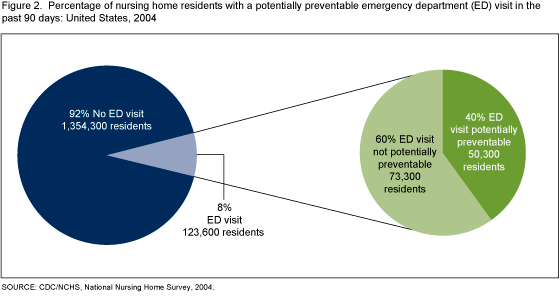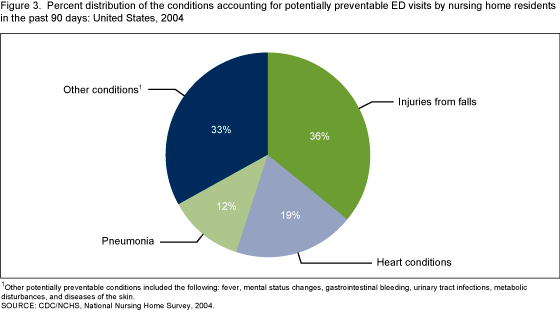Potentially Preventable Emergency Department Visits by Nursing Home Residents: United States, 2004
On This Page
- Key findings
- Eight percent of nursing home residents had an ED visit in the past 90 days.
- Among nursing home residents with an ED visit in the past 90 days, 40 percent had a potentially preventable ED visit.
- Injuries from falls were the most common conditions accounting for potentially preventable ED visits by nursing home residents.
- Nursing home residents who had a potentially preventable ED visit in the past 90 days had shorter lengths of stay and more medications.
- Summary
- Definitions
- Data source and methods
- About the authors
- References
- Suggested citation
NCHS Data Brief No. 33, April 2010
PDF Version (387 KB)
Christine Caffrey, Ph.D., Division of Health Care Statistics.
Key findings
Data from the National Nursing Home Survey, 2004
- In 2004, 8 percent of U.S. nursing home residents had an emergency department (ED) visit in the past 90 days.
- Among nursing home residents with an ED visit in the past 90 days, 40 percent had a potentially preventable ED visit.
- Injuries from falls were the most common conditions accounting for potentially preventable ED visits by nursing home residents.
- Nursing home residents who had a potentially preventable ED visit in the past 90 days had shorter lengths of stay and more medications
In 2004, there were over 110 million visits to EDs throughout the United States (1). Older adults, particularly nursing home residents, comprise a large and growing percentage of those visiting the ED (2,3). Prior research has identified conditions that may lead to potentially preventable visits to an ED among nursing home residents (4–11). Fever, chest pain, heart disease (mainly heart failure), mental status changes, gastrointestinal bleeding, urinary tract infections, metabolic disturbances, pneumonia, diseases of the skin, and injuries due to falls have been identified as reasons for potentially preventable visits to an ED. Researchers argue that some of these conditions, such as urinary tract infections, could be more appropriately treated in the nursing home. Other conditions prompting ED visits, such as those related to falls or pneumonia, may have been avoided by preventing the adverse health event itself. Decreasing potentially preventable visits to EDs may reduce health care costs, lessen trauma or complications resulting from medical treatment for nursing home residents, and improve quality of care. This report presents the only national information on potentially preventable ED use among U.S. nursing home residents.
Keywords: long-term care, emergency care, quality of care
Eight percent of nursing home residents had an ED visit in the past 90 days.

Eight percent of nursing home residents in 2004 had at least one ED visit in the past 90 days, representing 123,600 residents nationally (Figure 1). Of those nursing home residents with an ED visit in the past 90 days, 15 percent had two or more ED visits in that time period, representing 18,400 residents nationally.
Among nursing home residents with an ED visit in the past 90 days, 40 percent had a potentially preventable ED visit.

Among nursing home residents with an ED visit in the past 90 days, 40 percent had potentially preventable ED visits (Figure 2). Residents with a potentially preventable ED visit represented 3 percent of all U.S. nursing home residents.
Injuries from falls were the most common conditions accounting for potentially preventable ED visits by nursing home residents.

Injuries related to falls accounted for over one-third of the potentially preventable ED visits (Figure 3). Symptoms of heart conditions (mainly chest pain, pressure, burning, and heart failure) accounted for almost 20 percent and pneumonia for 12 percent of the potentially preventable ED visits. The remaining one-third included mental status changes, urinary tract infections, gastrointestinal bleeding symptoms, fever, metabolic disturbances, and skin diseases.
Nursing home residents who had a potentially preventable ED visit in the past 90 days had shorter lengths of stay and more medications.
Table. Percentage of selected resident characteristics among nursing home residents with and without a potentially preventable ED visit: United States, 2004
| Characteristic1 | Residents with potentially preventable ED visit | Other nursing home residents |
|---|---|---|
| Length of stay more than 6 months | 64 | 70 |
| Taking nine or more medications | 56 | 50 |
1 Differences are defined as statistically significant at p < .05.
SOURCE: CDC/NCHS, National Nursing Home Survey, 2004.
Among residents with potentially preventable ED visits in the past 90 days, 64 percent had a length of stay more than 6 months compared with 70 percent of all other nursing home residents; and 56 percent had nine or more medications compared with 50 percent of all other nursing home residents (see table).
Summary
Overall, 8 percent of nursing home residents in 2004 had visited an ED in the past 90 days. A substantial percentage of those with an ED visit in the past 90 days had conditions that have been linked to potentially preventable visits. Injuries from falls were the most common conditions. Nursing home residents who had a potentially preventable ED visit in the past 90 days had shorter lengths of stay and more medications. This report identifies conditions and resident characteristics that nursing homes and policymakers might target to reduce preventable ED visits.
Definitions
Emergency Department Visits: Measured using a question that asked, “Since admission/In the past 90 days, has the selected resident had one or more hospital emergency department visits?” ED visit status was missing for 94 cases, representing 14,345 residents missing nationally. The question included the following probe, “Please include visits that occurred after the selected resident’s most recent admission to the nursing home.” Up to five visits were documented. Number of ED visits was missing for two cases, representing 286 residents missing nationally.
Reason for Potentially Preventable Emergency Department Visits: defined by a response to the following question, “What was the primary reason for the visit(s)?” It should be noted that the Reason for Visit Classification system was used to code these data rather than the International Classification of Diseases, Ninth Revision codes (11). This study focused on the following conditions associated with potentially preventable emergency department visits and hospitalizations: general fever symptoms―includes high temperature (1010), general chest pain symptoms―includes chest discomfort, pressure, tightness, and burning, and excludes heart pain (1050.1), heart disease symptoms―mainly congestive heart failure (2520), symptoms of mental status changes―like mood swings, wandering around, disoriented, and non-communicative (1165), gastrointestinal bleeding symptoms―includes conditions such as blood in stool and vomiting blood (1580), urinary tract infection symptoms (1675), metabolic disturbance diseases―includes conditions such as low blood sugar, hypoglycemia, and poor nutrition (2215), pneumonia―such as viral, bacterial, and broncho pneumonia (2630), diseases of the skin―includes conditions such as cellulitis, seborrheic dandruff, eczema, psoriasis, and allergic skin reactions (2800–2899), and injuries due to falls (5810).
Data source and methods
The 2004 National Nursing Home Survey (NNHS) data were used for these analyses. NNHS is a periodic cross-sectional survey of a nationally representative sample of U.S. nursing homes. It is designed to provide descriptive information on nursing homes, their services, their staff members, and the residents they serve.
The sample design for the 2004 NNHS was a stratified, multistage probability design. The first stage was the selection of facilities and the second stage was the selection of residents. The primary sampling strata of facilities were defined by sampling bed size category and metropolitan area status. For the 2004 NNHS, 1,500 nursing homes were selected using systematic statistical sampling with probability proportional to their bed sizes. The second stage sampling of current residents was carried out by the interviewers at the time of their visits to the facilities. The sampling frame for current residents was the total number of residents on the register of the facility as of midnight the day before the survey interview. A sample of up to 12 current residents per facility was selected, resulting in a total of 14,017 residents. The 2004 NNHS was administered using a computer-assisted personal interviewing (CAPI) system. Data were collected on facility characteristics and characteristics of the sampled residents.
Data analyses were performed using the statistical packages SAS version 9.1 (SAS Institute, Cary, N.C.) and SUDAAN version 9.0 (Research Triangle Institute, Research Triangle Park, N.C.).
About the authors
Christine Caffrey is with the Centers for Disease Control and Prevention’s National Center for Health Statistics, Division of Health Care Statistics, Long-Term Care Statistics Branch.
References
- National Center for Health Statistics. Health, United States, 2006 with Chartbook on Trends in the Health of Americans. Hyattsville, MD: National Center for Health Statistics. 2006.
- Terrell K, Hustey F, Hwang U, Gerson L, Wenger N, Miller D. Quality indicators for geriatric emergency care. Acad Emerg Med (ePub ahead of print). 2009.
- Pitts S, Niska R, Xu J, Burt C. National Hospital Ambulatory Medical Care Survey: 2006 emergency department summary. National health statistics reports; no 7. 2008.
- Carter M, Porell F. Vulnerable populations at risk of potentially avoidable hospitalizations: The case of nursing home residents with Alzheimer’s disease. Am J Alzheimers Dis Other Demen; 20(6):349–58. 2005.
- Dosa D. Should I hospitalize my resident with nursing home-acquired pneumonia? J Am Med Dir Assoc; 7(3 Suppl):S74–80. 2005. 2005.
- Grabowski D, O’Malley AJ, Barhydt N. The costs and potential savings associated with nursing home hospitalizations. Med Care; 26(6):1753–61. 2007.
- Intrator O, Zinn J, Mor V. Nursing home characteristics and potentially preventable hospitalizations of long-stay residents. J Am Geriatr Soc; 52: 1730–6. 2004.
- Ouslander J, Weinberg A, Phillips V. Inappropriate hospitalization of nursing facility residents: A symptom of a sick system of care for frail older people. J Am Geriatr Soc; 48(2): 230–1. 2000.
- Rogers M, Fries B, Kaufman S, Mody L, McMahon L, Saint S. Mobility and other predictors of hospitalization for urinary tract infection: A retrospective cohort study. BMC Geriatr; 8:31. 2008.
- Saliba D, Kington R, Buchanan J, Bell R, et al. Appropriateness of the decision to transfer nursing facility residents to the hospital. J Am Geriatr Soc; 48(2): 154–63. 2000.
- Schneider D, Appleton L, McLemore T. A reason for visit classification for ambulatory care. National Center for Health Statistics. Vital Health Stat 2(78). 1979.
Suggested citation
Caffrey C. Potentially preventable emergency department visits by nursing home residents: United States, 2004. NCHS data brief, no 33. Hyattsville, MD: National Center for Health Statistics. 2010.
Copyright information
All material appearing in this report is in the public domain and may be reproduced or copied without permission; citation as to source, however, is appreciated.
National Center for Health Statistics
Edward J. Sondik, Ph.D., Director
Jennifer H. Madans, Ph.D., Associate Director for Science
Division of Health Care Statistics
Jane E. Sisk, Ph.D., Director
- Page last reviewed: November 6, 2015
- Page last updated: April 2, 2010
- Content source:


 ShareCompartir
ShareCompartir